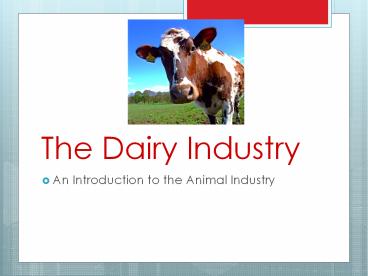The Dairy Industry PowerPoint PPT Presentation
Title: The Dairy Industry
1
The Dairy Industry
- An Introduction to the Animal Industry
2
Name at least twenty food items butter goes great
with.
- Warm-up
3
Why Dairy?
- high nutritional value high in protein and
essential vitamins and minerals - milk comes from the cow as processed food and
requires very little additional processing - other dairy products include cheese, butter,
yogurt, and ice cream
4
How much dairy do we eat?
- In the U.S., every year the average person
consumes - 29 gallons of milk
- 24 pounds of cheese
- 16 pounds of ice cream
- 4 pounds of butter
- 4 pounds of yogurt
5
Where does milk come from?
- every state produces milk but most milk comes
from California, Wisconsin, New York,
Pennsylvania, and Minnesota - Holsteins (think Chick-Fil-A cows) make up most
of the dairy population - Jerseys (the Mayfield cow) rank 2nd
6
Dont Forget about Goats!
- can survive and produce milk on a lower quality
forage and less land than is needed for cows - very important in developing countries and are a
dual-purpose animal (can be used for milk and
meat) - In the U.S., most dairy goats are kept by
hobbyists but goat milk is becoming more popular.
7
Milk Production
- must produce a calf each year to produce milk
- colostrum the first milk after giving birth,
high in nutrients and antibodies for the calf - grazed on pasture and fed silage (chopped green
corn and other crops that are fermented to help
preserve the feed) - in the past, cows had to be milked by hand now
milking machines are used
8
Dairy Products all originate at the dairy farm
9
Most Dairy Products in the US come from Dairy
Cows with Holsteins being the most prominent
breed.
10
The Farm
The cows are placed in the holding pen while they
are waiting to be milked.
11
The Farm
Workers view of the parlor
Cows view of the parlor
Next, the cows are placed in the milking parlor.
This is where the actual milking takes place.
12
The Farm
Milking unit
The cows are lined up one behind the other at an
angle so that the utters are facing the milking
units
13
The Farm
Cows teat (1 of 4)
The teats have been sprayed with teat dip in
order to clean them before milking and will be
wiped off with a clean paper towel before the
milker is placed on the teats.
14
The Farm
After the teats are cleaned the milking unit is
then placed on the cow. The average milking time
for a cow is five minutes.
15
The Farm
Automatic wash system- runs sanitation wash
through all pipes and milking units to sanitize
after each milking.
Pulsator- provides suction for the milking units.
Main control to the milking system.
16
The Farm
The milk from the cows will finally end up in the
bulk tank. When the milk truck driver arrives it
is his responsibility to take samples of the milk
from the bulk tank.
17
From the Cow to Your Table
milk harvested from the cows in the parlor
fluid milk is rapidly cooled in a holding tank
(the bulk tank)
a tanker truck picks up the milk and hauls it to
the processing plant
milk is tested for bacteria and drug residues
after filtering and removing the cream, the milk
is homogenized so it will not separate out
pasteurization (heating and cooling the milk)
kills harmful bacteria
packaged and sent to retail stores
18
BST
- bovine somatotropin (BST)
- a naturally occurring hormone used to stimulate
increased milk production (all milk contains BST) - it is digested and does not get into the human
bloodstream - the FDA has determined that it is safe for both
cows and humans
19
Grades of Milk
- Grade A the only milk that can be used for
beverage or fluid milk - farms are held to strict regulations for
cleanliness and other standards to be able to
sell Grade A milk - Grade A milk is also used for manufactured
products - Grade B can only be used for manufactured
products not fluid products
20
Cheese Production
- a starter culture of bacteria is added to
pasteurized milk - fermentation changes the sugars to acids which
causes the milk to form a solid called curd - rennet (an enzyme) is added to speed up the
process - liquid is drained off (called whey)
- the curd is then heated to contract and get rid
of any remaining whey - the cheese is then salted, pressed into a form,
and cured or aged
21
Yogurt
- a processed milk product that is eaten frozen or
in soft form - concentrated milk is heated and then rapidly
cooled - bacterial cultures are added to cause the milk to
ferment - this causes the acidity to increase (helps
preserve the yogurt) and produces the flavor - packaged with fruit or other flavorings

